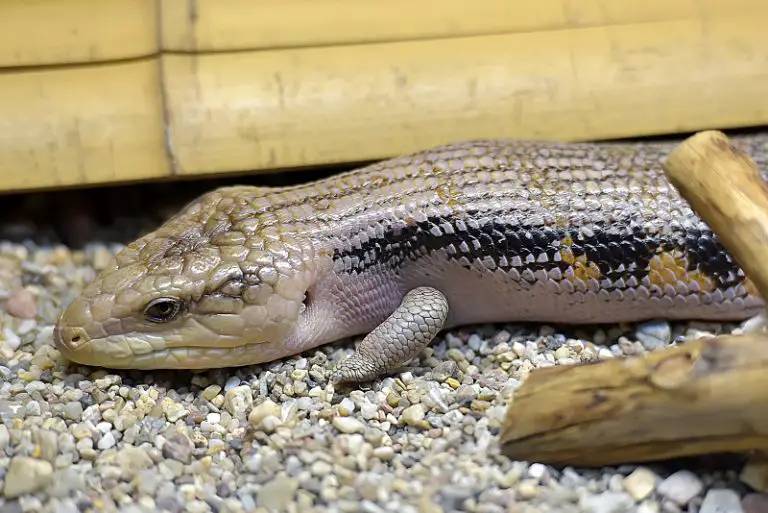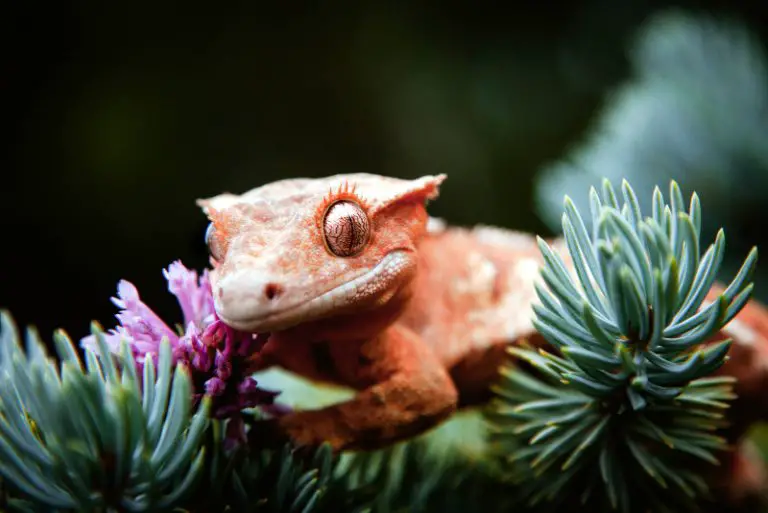What To Feed Leopard Geckos [Full Diet Guide]

One of the most important things to know when picking a reptile is what to feed Leopard Geckos. Reptiles can be found all over the world in different climates, so they have different diets and preferences. Leopard geckos are a great choice if you don’t mind caring for feeder insects. Unlike some pet lizards who are perfectly happy eating food that doesn’t move, leopard geckos like their food to be fresh.
![What To Feed Leopard Geckos [Full Diet Guide]](https://allourcreatures.com/wp-content/uploads/2021/12/What-To-Feed-Leopard-Geckos-Full-Diet-Guide-800x419.png)
Contents
Table of Contents
What To Feed Leopard Geckos?
Leopard geckos are strictly insectivores, meaning they like to eat insects. It isn’t necessarily as simple as that, though. There are some insects that are healthier than others, and some that geckos prefer over others. To find out more about your leopard gecko’s diet, keep reading. Below, I cover what can you feed a leopard gecko including what does a leopard gecko eat in the wild. I also cover whether leopard geckos need supplements, how often they eat and the answer to how much should I feed my leopard gecko. I also discuss how and when to feed leopard geckos.
Let’s start!
What Is A Leopard Gecko?
Leopard geckos are one of the most popular reptiles in the pet trade. They get their names from the coloration of their bodies: a light yellow or cream color with dark spots. They are also sometimes called panther geckos because of their colors.
These lizards are moderate in size with most reaching about 7-10 inches in length. If you care for them properly, you can have a friend in your leopard gecko for up to 20 years!
These little lizards prefer the warmer, dry climates of desert-like regions. In the wild, they can be found in southern Asia, Pakistan, India, Iran, Iraq, and southeast Afghanistan. Although they are most commonly found in the desert, they can also be found in patchy grasslands and even atop tall mountains.
What Do Leopard Geckos Eat In The Wild?
A leopard gecko’s diet in the wild is similar to its diet as a pet. Leopard geckos are insectivores, so their diets are somewhat limited. However, a wild gecko’s diet is likely to be more diverse than a pet lizard because there will be more insects to choose from.
Insects
As a pet, a leopard gecko’s diet will mainly consist of crickets and worms (more on that later). In the wild, they will also feed on crickets and worms, but they’ll also eat a lot of other insects.
Insects like spiders, centipedes, scorpions, and even other lizards are commonly a staple in a leopard gecko’s diet.
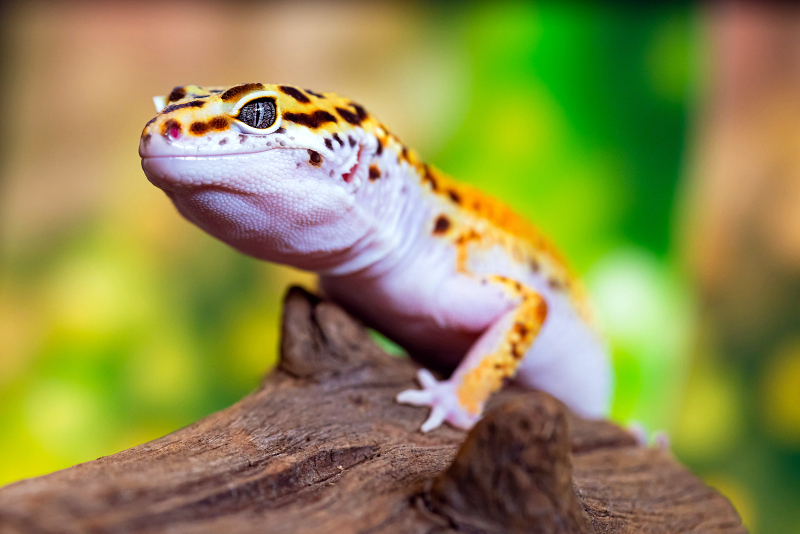
Hunting
In the wild, leopard geckos must hunt for their food. This is likely why captive leopard geckos have retained their hunting instinct and prefer to eat live insects. Leopard geckos are also nocturnal and will do all of their hunting at night. Pet geckos have also retained this habit and will come out at night to eat and be active.
A leopard gecko’s senses are very in-tune with everything going on around them. They are very adept at tracking and detecting insects around them. This allows them to easily find their prey and not go hungry.
Vitamins & Minerals
As most lizard owners know, it’s very important for your lizard to obtain supplements like calcium and vitamin D3. This is simple in captivity since we can purchase supplements. We can also pick and choose which insects to give our geckos.
In the wild, geckos aren’t going to know which insects have more calcium than others. They’re also not going to sprinkle calcium supplements onto their meals before eating them. So, how do they get these supplements in the wild?
It’s quite simple, really. Hard-shelled insects are in abundance in the leopard gecko’s natural habitats. These hard-shelled insects are rich in calcium and minerals that are important in the wild gecko’s diet.
If they’re not getting enough nutrition from the insects alone, they will also lick minerals off rocks and the surface of plants.
D3 on the other hand is easily obtained from the sun. This is why it’s so important to include a UVA and UVB bulb in our gecko’s terrarium. Light from the sun is vitally important to any lizard’s health.
Watch this video: What To Feed Leopard Geckos
What To Feed Leopard Geckos
What can leopard geckos eat besides insects? Nothing!
As we said before, leopard geckos are strictly insectivores. But when it comes to insects, what can a leopard gecko eat?
Basic Nutrition
As we said before, calcium is very important in your leopard gecko’s diet. When considering an insect for your leopard gecko, you should consider the calcium to phosphorous ratio. For leopard geckos, the ideal ratio is 2:1.
You always want to have more calcium than phosphorous. Too much phosphorous can cause a depletion in calcium. Unfortunately, there aren’t many insects that have more calcium than phosphorous which is why insects should be coated in calcium powder. More on that later.
You should also look at the protein and fat content. Always opt for insects with a higher protein content, and avoid those with lots of fat. Insects high in fat should only be given occasionally as treats.
Staples
Staple foods are the most nutritious options and are okay to feed your gecko at every meal. If you were wondering what to feed a leopard gecko regularly, these are it. The two most popular are crickets and mealworms.
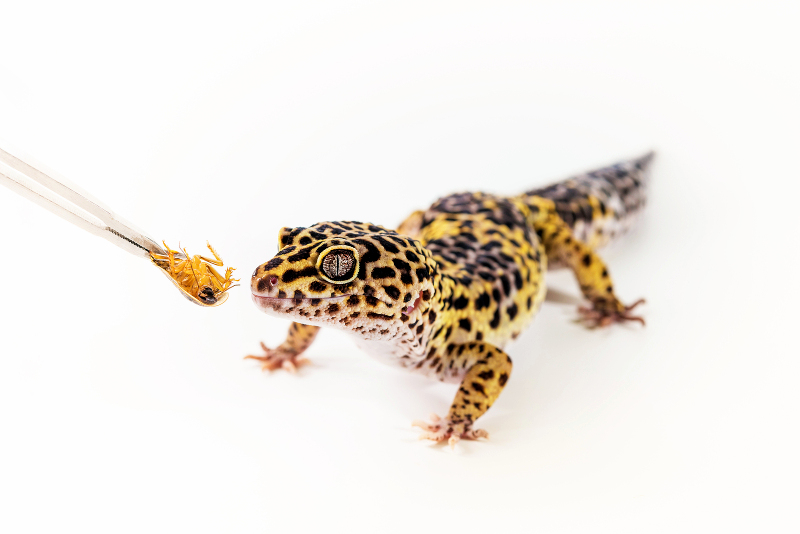
Crickets
Crickets are one of the most well-rounded foods you can provide your gecko. They are very high in protein and low in fat content. Their Ca:P ratio is poor, but this can be solved by dusting with calcium powder.
They are also great because of how active they are. Crickets love to run and jump around the cage, and this brings out your gecko’s hunting instinct.
Hunting ensures that your gecko is getting plenty of food, but it also provides enrichment. It’s exciting and gives their mind something to focus on. It also ensures that they’re getting plenty of exercise.
Mealworms
Mealworms are another great option for your gecko because of how nutritious they are. These are just as high as crickets in protein content, although they are a bit higher in fat. Their Ca:P ratio is a bit better, but they still need to be dusted with calcium.
The only problem with mealworms is that they don’t move around as much as crickets. You might find that your gecko isn’t interested in eating the mealworms you provide because they just lay around in the feeding dish.
If this is the case, try holding a mealworm in front of your gecko’s face with a pair of feeding tongs. Wiggle the worm around a few inches from your gecko’s face. That will usually encourage them to eat.
Other Staples
Other nutritious food for leopard geckos include silkworms, Pheonix worms, hornworms, and roaches.
Snacks
Snack insects usually include some of your gecko’s favorite foods. But, they also include the more unhealthy foods that really shouldn’t be fed very often. These include:
- Superworms
- Waxworms
- Butterworms
Geckos love these worms, and for good reason: they’re very fatty! The fattiness makes them very tasty, but also unhealthy for your gecko. For this reason, they should only be given as a treat about once a week.
Below, we’ve included a chart detailing the nutrition facts of leopard gecko’s favorite insects:
| Feeder Insect | Protein % | Fat % | Ca:P Ratio |
| Crickets | 19% | 5% | 1:9 |
| Mealworms | 19% | 9% | 1:7 |
| Roaches | ~20% | ~8% | 1:3 |
| Silkworms | 13% | 2% | 1:2.4 |
| Pheonix Worms | 18% | 10% | 1.5:1 |
| Hornworms | 9% | 3% | 1:3 |
| Butterworms | 16% | 17% | 1:18 |
| Waxworms | 15% | 22% | 1:17 |
| Superworms | 19% | 18% | 1:18 |
Supplements
It is incredibly important for your gecko to receive extra supplements in their diet. Of course, you should be feeding them the most nutritious insects, but that’s not always enough.
Supplements
Calcium is the #1 most important supplement to include in your gecko’s diet. Without calcium, their bones become weak and they can develop a host of painful problems.
Calcium is especially important in juvenile crickets because it helps them grow. With a calcium deficiency, baby geckos can develop metabolic bone disease. This will cause their bones to develop improperly, and it cannot be reversed.
Fortunately, it’s easy to provide calcium. Simply dust your feeder insects in a coating of calcium before giving them to them. You can also pick insects that are high in calcium content to begin with.
Multi Vitamins
Other vitamins are important to provide your gecko as well, but they don’t need to be given as often. Vitamins are also easy to provide your gecko through their insects.
Like calcium, there are vitamin powders that you can dust over your insects. Just don’t dust vitamins and calcium on your insects at the same time. This can cause your gecko to become overdosed with supplements.
Another way to provide vitamins is through your insect’s food. There are a lot of insect foods that are gel-like and are rich in vitamins and nutrients. When the insects eat these nutritious foods, the nutrients automatically transfer to your gecko when it eats the insects.

What NOT To Feed
Leopard geckos are strictly insectivores and cannot eat fruit. Their bodies simply cannot digest it. They don’t have the correct organs needed to process plant matter. Feeding them fruit and veggies can make them quite sick.
Raw meat should not be given to your geckos either. Raw meat is usually very high in fat. It can also carry dangerous bacteria. Cooked meat is no better because it looses its nutrients.
NEVER feed your gecko wild insects. They can be filled with dangerous diseases or pesticides that could harm or kill your gecko.
Read more about feeding leopard geckos fruit here and click here for more information about feeding them vegetables.
Example Leopard Gecko Diet
When feeding an adult leopard gecko, they should only be fed every 2-3 days. The size of the insects can vary a bit depending on the size of you gecko. Insects can be between the sizes of 1/2″ and 3/4″.
You should give two insects for every inch of your gecko’s body length. The larger the gecko, the more they’ll need to be fed.
It’s always a good idea to give your gecko plenty of variety. Different insects contain different kinds of nutrients. You’re doing them a disservice by only feeding them one insect their whole life. Feeding them a variety keeps their diet well balanced.
Here is an example of a diet you could feed your leopard gecko throughout the week:
| Sunday | Monday | Tuesday | Wednesday | Thursday | Friday | Saturday |
| Crickets | Mealworms | Treat | Crickets |
Here is an example of a supplement schedule for your leopard gecko:
| Age | Calcium Powder | Vitamin Powder |
| 0-6 months | 5 days a week | 2 days a week |
| 6-12 months | 2-3 days a week | 1 day a week |
| 12+ months | 6-8 days a month | 2-3 days a month |
What To Feed Baby Leopard Geckos
What do baby leopard geckos eat?
Baby leopard geckos are going to be fed the same things that the adult geckos are going to be fed. The difference is that baby’s are going to be fed every single day, and their food is going to be significantly smaller. You’ll also want to make sure your baby gecko is receiving extra calcium.
Here is a general guide for feeding your baby gecko:
| Age | Insect Size | Feeding Frequency |
| 0-6 months | 3/8″ | Every Day |
| 6-12 months | 1/4″ | Every Day |
Baby geckos should be given a large amount of insects with every feeding. Let them eat as much as they can for 15 minutes, then remove whatever is leftover.
How Often Do Leopard Geckos Eat?
How often they eat and how often should leopard geckos eat is different. They will eat as much as you put in front of them. But, how often should you feed a leopard gecko, really?
This depends on the life stage of your leopard gecko. Baby’s need lots of nutrients and should be fed every day. When they become adults, you can cut down their feeding to every 2-3 days.
How Much Do Leopard Geckos Eat?
You may have questions about how much to feed a leopard gecko.
We covered this above, but this also varies based on your gecko’s age. Baby geckos need more food and should be given as much as they can eat in 15 minutes. Adults won’t need as much, but should be given two insects for every inch of their body.
What Time Should I Feed My Leopard Gecko?
When do leopard geckos eat?
Leopard geckos are considered crepuscular animals. Many people have not heard this term before. Usually, we are familiar with nocturnal animals (those awake at night) and diurnal animals (those awake during the day). Not everyone has heard of crepuscular animals, though.
Crepuscular VS Nocturnal
Being crepuscular is very similar to being nocturnal, but with a few differences. Being nocturnal means you are most active at night and that you stay active throughout the night. Being crepuscular means that you are most active during dawn and dusk, and are less active through the night. It still means that you sleep throughout the day, though.
Being crepuscular isn’t a problem for most leopard gecko owners, however. Most people are away for work during the day, allowing their geckos to sleep. When they arrive home, the sun is usually just beginning to go down. This means your gecko will just be waking up, and you can spend time with them.
Feeding At Dusk
Because they are most active during dawn and dusk, it’s best to feed them at dusk, just as they are waking up. They will be more active at this time and will be more likely to eat. If they decide not to eat all their food at once, it will give them plenty of time to eat throughout the night.
It’s not recommended to feed them at dawn because it only gives them a short amount of time to eat. If the sun comes out fully before your gecko has finished eating, they may be tempted to stay awake until they finish their meal. This can throw off their sleep cycle.
How To Feed Leopard Geckos
It’s not enough to know what to feed your leopard gecko and how often you should feed them. It’s also important that you know how to feed them.
At Night
As we stated above, you should always feed your gecko in the evening when they are first waking up.
Insect Size
You also need to be conscious of the size of the insects you’re giving. If you give an insect that is too big, it can cause impaction, or it could cause them to choke. This goes for both juvenile and adult lizards. The smaller the lizard, the smaller their food should be.
The general rule is to not give your gecko insects bigger than the width of the space between their eyes.
Gut Loading
You should also “gut load” the insects you feed your crickets. Gut loading simply means that you feed the insects a nutritious meal for a few days before feeding them to your reptile. This will ensure that your gecko is receiving a full-spectrum of nutrition from their food.
Gut loading is really easy because pet stores sell food made specifically for insects. You just need to find the appropriate food for the kind of insect you’re housing. Throw that food into the insect’s enclosure and they will begin eating.
It’s also important to dust the insects in calcium before feeding them to your lizard. Calcium is extremely important to reptiles. Without calcium, they can develop painful and irreversible bone problems. Dusting insects with a little bit of calcium before feeding can prevent this.
Frequently Asked Questions
How Many Mealworms Or Crickets To Feed A Leopard Gecko?
This depends on the gecko’s age. As juveniles, you can usually feed about 4-8 insects at a time. As adults, you should give two insects for every inch of the lizard’s length.
Can Leopard Geckos Eat Eggs?
You should not feed your gecko eggs — stick to live feeder insects. They likely won’t be interested in eggs anyway.
What Insects Do Leopard Geckos Eat?
We covered this question more in-depth above. However, some favorite foods include crickets, mealworms, roaches, and silkworms.
Do You Have To Feed Leopard Geckos Live Insects?
You can certainly try to feed your gecko dead insects, but it likely won’t go well. Leopard geckos usually aren’t interested in things that don’t move. Dead insects aren’t as nutritious as live ones, either.
Conclusion
There is a lot that goes into feeding your leopard gecko, but with some patience, you can master it. Provide your gecko with lots of supplements and live insects and they will be a happy companion for years to come!
Want to learn more? Click here to find all our guides to geckos or click here for our full guide to how often leopard geckos need to eat.

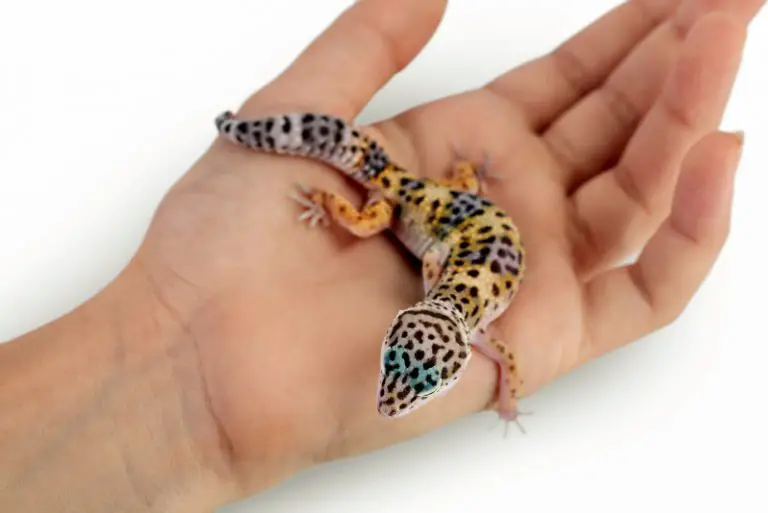
![What Fruit Can Crested Geckos Eat? [Best Fruit]](https://allourcreatures.com/wp-content/uploads/2021/12/crested-gecko-768x513.jpg)
